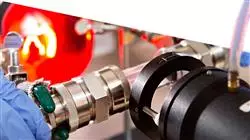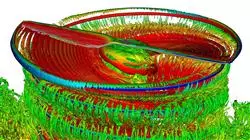University certificate
The world's largest faculty of engineering”
Description
Become an expert in all kinds of CFD Techniques and learn to get the most out of them”

The Finite Volume Method (FVM) is the most widely used method in Computational Fluid Mechanics. But there are alternative techniques that are also very suitable and have more specific applications. To know this series of methods, specific and highly advanced knowledge in this matter is necessary, which has caused companies to increasingly demand expert professionals in this area.
This is the reason why TECH has created a postgraduate diploma in Unconventional CFD Techniques, with the aim of providing its students with the most complete and up-to-date knowledge, as well as the best skills, so that they can face a professional future in this field, with total guarantee of success. Thus, throughout the agenda, calculation techniques such as Smoothed Particle Hydrodynamics, Monte Carlo Direct Simulation, the Lattice-Boltzmann Method or the aforementioned Finite Element Method are analyzed and addressed, among other topics, such as the Multiphysics Simulations or Numerical Methods and Fundamentals of Fluid Physics.
All this in a comfortable 100% online modality that allows students to combine their studies with their other day-to-day activities, without having to adapt to new schedules or travel. In addition, throughout this degree, the most complete, dynamic and practical content possible is offered, accessible from any device with an Internet connection, be it a tablet, mobile phone or computer.
Strengthen your professional profile with new knowledge in FEM, SPH or DSMC”
This postgraduate diploma in Unconventional CFD Techniques contains the most complete and up-to-date program on the market. The most important features include:
- The development of practical cases presented by experts in Unconventional CFD Techniques
- The graphic, schematic, and practical contents with which they are created, provide scientific and practical information on the disciplines that are essential for professional practice
- Practical exercises where self-assessment can be used to improve learning
- Its special emphasis on innovative methodologies
- Theoretical lessons, questions for the expert, debate forums on controversial topics, and individual reflection assignments
- Content that is accessible from any fixed or portable device with an Internet connection
Enroll now and access all the content on the Lattice - Boltzmann Method”
The program’s teaching staff includes professionals from the sector who contribute their work experience to this educational program, as well as renowned specialists from leading societies and prestigious universities.
Its multimedia content, developed with the latest educational technology, will provide the professional with situated and contextual learning, i.e., a simulated environment that will provide an immersive education designed to learn in real situations.
The design of this program focuses on Problem-Based Learning, by means of which the professional must try to solve different professional practice situations that are presented throughout the academic course. For this purpose, the student will be assisted by an innovative interactive video system created by renowned experts.
Acquire new skills in the field of Multiphysics Simulations, in a few months and without leaving home"

You will be able to enhance your profile in CFD Techniques, thanks to the most complete theoretical and practical material"
Objectives
The objective of this postgraduate diploma in Unconventional CFD Techniques is to delve into alternative techniques within Computational Fluid Mechanics, to provide students with advanced skills and knowledge in other methods that enable them to enhance their profile and get the most out of it. performance of these techniques. All this, through the most complete and updated contents of the current academic market.

Give your career a boost and specialize in one of the fields with the greatest future in engineering”
General Objectives
- Establish the bases of the study of turbulence
- Develop statistical concepts of CFD
- Determine the main calculation techniques in turbulence research
- Generate specialized knowledge in the method of Finite Volumes
- Acquire specialized knowledge in techniques for calculating fluid mechanics
- Examine the wall units and the various regions of a turbulent wall flow
- Determine the characteristics of compressible flows
- Browse multiple models and multiphase methods
- Develop specialized knowledge about the multiple models and methods in multiphysics and in thermal analysis
- Interpret the results obtained through a correct post-processing
Specific Objectives
Module 1. Advanced Methods for CFD
- Develop the Finite Element Method and the Hydrodynamics Method Smoothed Particle
- Analyze the advantages of the Lagrangian methods compared to the Eulerian ones, in particular, SPH vs FVM
- Analyze the Monte-Carlo Direct Simulation method and the Method Lattice-Boltzmann
- Evaluate and interpret simulations of space aerodynamics and microfluidic dynamics
- Establish the advantages and disadvantages of LBM compared to the traditional FVM method
Module 2. Advanced CFD Models
- Distinguish what type of physical interactions are going to be simulated: fluid-structure, such as a wing subjected to aerodynamic forces, fluid coupled with rigid body dynamics, such as simulating the movement of a buoy floating in the sea, or thermofluid, such as simulating the distribution of temperatures in a solid subject to currents of air
- Distinguish the most common data exchange schemes between different simulation software and when one can or is better to apply one or the other
- Examine the various patterns of heat transfer and how they can affect to a fluid
- Model convection, radiation and diffusion phenomena from a fluid point of view, model the creation of sound by a fluid, model simulations with advection-diffusion terms to simulate continuums or particles and model reactive flows
Module 3. Post-processing, validation and application in CFD
- Determine the types of post-processing according to the results to be analyzed: purely numerical, visual, or a mixture of both
- Analyze the convergence of a CFD simulation
- Establish the need to carry out a CFD validation and know basic examples of it
- Browse the various tools available on the market
- Substantiate the current context of CFD simulation

Enroll now and enjoy the most innovative educational tools in CFD Techniques”
Postgraduate Diploma in Unconventional CFD Techniques
.
The use of simulation techniques in Engineering is becoming more and more common in different areas, including fluid dynamics simulation (CFD). The current technological development allows the realization of increasingly accurate simulations, which has allowed the exploration of new unconventional CFD techniques that seek to solve complex problems in the field of engineering. At TECH Global University, we offer the Postgraduate Diploma in Unconventional CFD Simulation Techniques, designed for professionals who seek to expand their knowledge in this field and apply innovative techniques in their projects.
In this Postgraduate Diploma program, you will learn how to develop and apply innovative CFD techniques to solve complex engineering problems.
In this program, we will study unconventional CFD techniques in depth, such as multiphase flow simulation, turbulence simulation, interface modeling and non-Newtonian fluid simulation. In addition, the development of advanced simulation and programming techniques with specialized software tools is addressed, allowing students to apply the knowledge acquired in solving real problems in the engineering area. Similarly, the program has a methodology that combines theoretical and practical classes, allowing students to apply the concepts learned in real projects and cases, in search of innovative solutions that add value to the industry.







